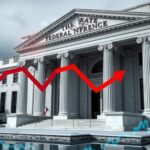Bitcoin Dips Below $90,000 Due to Fed Rate Cut Uncertainty
Bitcoin’s price dipped to $89,800, marking a five-week low amid Fed rate cut skepticism. This decline follows an all-time high of $108,000 and reflects broader market conditions influenced by employment data and anticipated monetary policy changes under the new administration. Analysts express cautious optimism about Bitcoin’s future performance despite existing market pressures.
On Monday, Bitcoin experienced a notable decline, plummeting to a five-week low of $89,800 and falling below the $90,000 threshold for the first time since mid-November. This drop follows a significant all-time high of $108,000 set nearly a month prior and reflects heightened market sensitivity to evolving monetary policies from the Federal Reserve. According to David Duong, Head of Institutional Research at Coinbase, recent labor data suggests that expectations for Fed rate cuts in 2025 may be overly optimistic, thereby exerting downward pressure on digital assets like Bitcoin.
Despite this pessimism, Duong maintains a cautiously optimistic outlook for Bitcoin’s performance in the first fiscal quarter of the year, acknowledging potential volatility ahead. With President-elect Donald Trump vowing to foster a more favorable regulatory environment for cryptocurrencies, speculations abound about his administration’s impact on Bitcoin adoption; however, skepticism regarding impending rate cuts from the Fed is prevalent.
Market analysts are closely watching upcoming economic indicators, particularly the Bureau of Labor Statistics’ upcoming inflation report. The markets reacted negatively last week when labor data revealed that 256,000 jobs were added in December, substantially exceeding expectations of 160,000. Senior Economist Aditya Bhave from BofA Global Research asserted that the resilient labor market diminishes the likelihood of forthcoming Fed rate cuts, reinforcing market stability, according to insights from Opening Bell Daily.
As of now, traders are recalibrating expectations regarding Fed policy, marking a 30% probability that rates will hold steady through the December meeting. This represents a significant increase from the 16% probability noted one week earlier. Historically, lower interest rates have provided a conducive environment for risk assets, including cryptocurrencies, aiding in inflation control through diminished borrowing costs and increased consumer spending. However, rising treasury yields have compelled caution across risk markets, with analysts reporting a rise in the 10-year treasury yield reaching its highest levels since October 2023.
Policy adjustments signal a more measured approach from the Fed, as they forecast fewer rate cuts than previously anticipated. Meeting minutes indicate a growing focus on potential shifts related to immigration and trade under the new administration, as policymakers remain vigilant of inflationary pressures that could arise from these changes.
The fluctuation of Bitcoin’s price is frequently influenced by macroeconomic factors, particularly decisions made by the Federal Reserve concerning interest rates. As digital currencies become more integrated into the financial system, external economic indicators, such as employment rates and inflation data, can significantly impact investor sentiment and market performance. With anticipated changes in U.S. leadership bringing promises of a more favorable crypto regulatory environment, traders are increasingly focused on both internal market factors and external economic indicators.
In summary, Bitcoin’s recent decline below $90,000 underscores the asset’s vulnerability to broader economic shifts influenced by Federal Reserve policies. Analysts suggest that the expected stability in interest rates may impede market recovery in the short term, despite some optimism for future performance. The interplay between regulatory developments under the new administration, inflation prospects, and employment data will be crucial for Bitcoin’s trajectory moving forward. Continued scrutiny of economic indicators will inform market expectations, as participants navigate the evolving fiscal landscape.
Original Source: decrypt.co








Post Comment